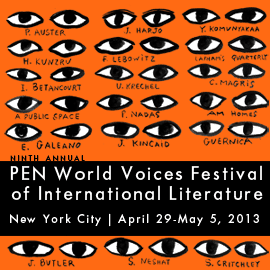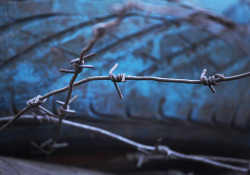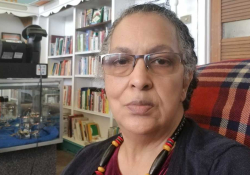PEN 2013: Bravery and Atrocity
 Bravery comes in many forms. As Salman Rushdie said to me in an interview, and confirmed at the opening night of PEN World Voices Festival of International Literature, the artist standing up to repression is just one kind of bravery. Another is the courage to create a new work of art and overcome technical or emotional challenges. And still, there are other forms of fearlessness and gallantry.
Bravery comes in many forms. As Salman Rushdie said to me in an interview, and confirmed at the opening night of PEN World Voices Festival of International Literature, the artist standing up to repression is just one kind of bravery. Another is the courage to create a new work of art and overcome technical or emotional challenges. And still, there are other forms of fearlessness and gallantry.
On the way to the Great Hall at Cooper Union (in which students squat in an attempt to maintain a free institution), I read Katherine Wilson’s fascinating essay on “atrocity literature,” published in the new issue of World Literature Today. Wilson describes a phenomenon in which literature ritten about or during a time of humanitarian crisis is transmitted and transmuted through multiple cultures for different reasons (some positive, others not), and thus becomes a subset of global literature that confirms a certain global experience: atrocity. “Their texts reveal an intimate awareness that their experiences correspond to a global pattern,” says Wilson. “Unavoidably, their testimonies represent works of comprarative genocide.”
As an example, Wilson’s uses Anne Frank: The Diary of a Young Girl, a canonical text that many in the West see as a tool for teaching about the horrors of the Holocaust. Although the book has appeared in languages as diverse as Farsi, Esperanto, and Sinhalese, and in lands as disparate as Iraq, France, Albania, Taiwan, Vietnam, and Brazil, translations like the one in North Korea can twist and mutate the details so that, in the case of the DPRK, George W. Bush takes the place of Nazis and is hell bent on destroying not the Jews, but the North Korean people. Still, in other places, like Cambodia, the Diary shows that Cambodians are not alone in experiencing horrific crimes against humanity.
The crux of Wilson’s argument is this: “If we look at the Diary’s circulation, what we actually see are (at least) three separate modes of transnational reception: first, as a translation affecting the way non-Western communities represent their experiences of genocide; second, as a text read by the protagnonists of novels; and third, as an authorizing force resulting in the rise of multiple foreign ‘Anne Franks.’ Compared with direct translation, each of these less direct modes represents a progressively more abstract relationship to the original.”
With Wilson’s argument top of mind during the evening’s event, I was tuned into the specter of genocide directly or obliquely referred to in the readings by Vaddey Ratner (Cambodia), Joy Harjo (American; Mvskoke/Creek Nation), Ursula Krechel (Germany), and Earl Lovelace (Trinidad and Tobago).
There is much to parse in Wilson’s argument (Go buy the magazine. Now.), but the one thread I will pick up here is her third: on the rise of foreign “Anne Franks,” specifically in Cambodia. It is a sublime coincidence that Wilson uses Cambodian atrocity literature as a prime source for her argument and that Ratner read from her novel, In the Shadow of the Banyan, a story told from the perspective of Raami, a young girl witnessing and living the reality of an atrocity—a genocide—in progress. “The problem with being seven is that you’re aware of so much, and yet you understand so little,” says Raami.
In her article, Wilson indicates there are multiple “Anne Franks" in Cambodia who wrote testimonies of the Cambodian genocide. After the publication of her memoir First They Killed My Father, Loung Ung was given the dubious moniker of the “Anne Frank of Pol Pot’s killing fields.” Another Cambodian memoirist, Chanrithy Him, is keenly aware of the Anne Frank comparison, though she seeks to distance herself from the Frank’s testimony. “While there are similarities in our stories,” says Him, “there are also differences, not the least of which is that the Cambodian Holocaust is underreported.”
None of this is to suggest that Ratner compares either her experience or narrative with Frank’s (though many have). She deliverd a touching reading in which “everywhere you look there is suffering,” where the characters of Banyan are either for or against the Khmer Rouge’s revolution. The stark choice was absolute; there was no ambiguity. “Weeds must be uprooted before they multiply,” one soldier says to the young girl.
Considering the phenomenon of “atrocity literature" and its varying (sometimes harmful) effects, I walked away from Ratner’s reading touched, but troubled. What expectaions are we to have toward Ratner’s text? Are we supposed to compare Banyan to a standard testimonial text like Frank’s Diary? Is there another text more appropriate for comparison? Are we to see Ratner as a Cambodian Anne Frank? Would Ratner feel comfortable with this relationship?
There is no doubt that Ratner is a brave writer. Alas, the real courage may rest with the reader: how will you approach her story?









